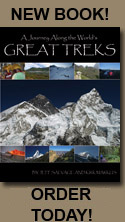 |
 |
Everest Base Camp Trek - Eyewitness Account, Breathing is Fundamental
From Lukla, we traveled towards our destination slowly gaining elevation. We started at 9,800 feet and gradually worked our way to the famous market town of Namche Bazaar where we acclimatized (to spend time adjusting to the altitude) for a day. Namche clings to a steep hillside overlooking the incredible valley and has stunning views on a clear day. If you can plan to be in Namche on a Sunday you can experience the famous market. The terraced mountainside clings to
From Namche it is on to Tengboche where there is a famous monastery by the same name. It is not really a town. It primarily consists of the monetary and surrounding guesthouses that serve trekkers and pilgrims. Climbers of Mt. Everest have historically gone here for blessings by the monks in advance of their dangerous summit bids for the top of the world. They receive a white scarf (a blessing for a safe journey) and offer a prayer to the mountains. The monastery is truly in a spectacular setting. It is surrounded by incredible peaks including Ama Dablam, Lhotse, Tamsherku, Kasem Kanguru and a glimpse of Everest over the top of the Nuptse ridge. The names of these peaks have engaged my dreams for many years of studying maps and reading books of this famous region. It is great to be here, finally, and see them with my own eyes.
For the most part we go up (ukalo in Nepali). Ukalo, ukalo, ukalo: it's not so bad except when you have to go back down and then right back up again. Your hard earned altitude is out the window and as I said before, elevation gain is a terrible thing to waste. But the Mountains Don’t Care” and it’s just business as usual on the roof of the world.
It's also very cold at the roof of the world. Nights are spent huddled around a wood or yak dung burning stove eating varying quality Dhal Bhat - the Nepali national dish. Dal Bhat is basically a thick lentil soup poured over rice augmented by a vegetable or meat (if you dare) curry. I find it quite tasty but after 12 days on the trail it gets a little boring. The Nepalese can eat it in copious quantities for breakfast, lunch and dinner, every day, without complaint. After dinner, tea and some chatting we retreat to our cold room and crawl into our sleeping bags and wait, skin shivering, for our body heat to warm the confines of our sleeping bags and slowly seep into our bones.
The story continues...



